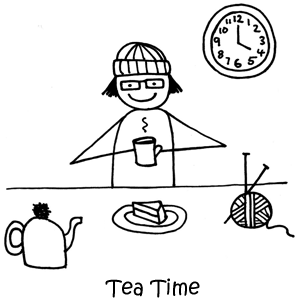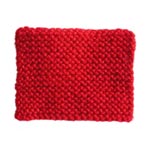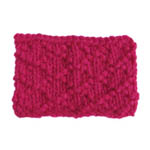Increasing Accuracy
When designing knitting with maths the stitch width and stitch height are used in almost all calculations. Here are a few ways to make our measurement of them more accurate.
1. Relax
You've just made your tension patch. The next step is to go and make a cup of tea.
Seriously.

OK, OK you can have a coffee instead, or how about a refreshing fruit juice? The important thing is that you leave your tension patch alone for a few minutes so that it can relax into its natural shape before measuring. This way your stitch measurements will reflect the fabric "at rest" and not straining in an odd direction.
2. Knit a Bigger Tension Patch
I realise that's more work, but by taking a bit more time and knitting a bigger tension patch you will be able to get a more accurate average measurement.
Imagine you have just made your tension patch and are trying to measure the width. No matter how neatly you knit the edges of the tension patch will go in and out a little. This means that you can not be sure that your measurement is accurate.
If we say that each edge can wobble in or out by 2mm (this is about average for knitting done on 3mm needles) then the measurement of the width may be different from the true width by ±4mm.

What if the Tension Patch is Small?
If a tension patch is 10 stitches across then each stitch width is accurate to ±4mm ÷ 10 = ±0.4mm
This means that an ODDknit made from a design that is 20 stitches across might be up to 8mm bigger or smaller than you expect. This is a lot of difference in a small object so you should probably knit a bigger tension patch.
What if the Tension Patch is Big?
If a tension patch is 40 stitches across then each stitch width is accurate to ±4mm ÷ 40 = ±0.1mm
An object made from a design that is 20 stitches accross might be 2mm too big or small (it would be hard to measure any difference at all). An object that is 100 stitches across might be 10mm too big or small. Considering how much knitting stretches I doubt you need to be any more accurate than that.
Similar arguments hold for measuring the height of the tension patch, but in that case you have to remember that you are averaging in the cast on and cast of edges as well. A cast on/off row might have a very similar height to a pattern row, but it might also be very different. The more pattern rows that are included in the calculation the less difference it will make if the height of the cast on/off edges are inconsistent.
3. Make Sure Any Pattern Repeats Exactly
When patterns are knitted individual stitches within the pattern may have different dimensions. We want to find the average stitch size so having an exact repeat of the pattern across the width of the row and height of the patch will make our results more accurate. In all honesty I usually ignore this point, but I wanted to mention it because it could make a difference to the measurements.
<<< Back to Tension.
© 2010-2016 All desgins and images are copyright of ODDknit.


